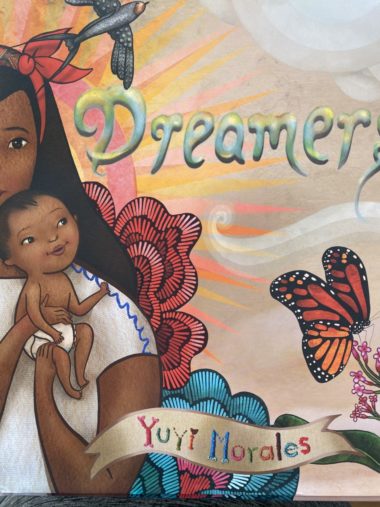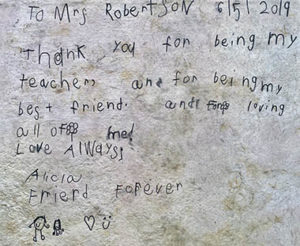What’s in a name? Everything, Alma Sofia Esperanza José Pura Candela would tell you. At first the title character in the picture book Alma and How She Got Her Name thought six names was far too long. “It never fits,” she complains to her father. But when he explains how her entire name honors the family’s history, culture and aspirations, she realizes it tells her not only where she came from but who she may become.
Oregon kindergarten teacher Gloria Pereyra-Robertson learned about Alma and How She Got Her Name from the NEA’s rebranded Read Across America program and calendar. She now regularly reads it in her kindergarten classroom to celebrate the diversity of her students from Central and South America, Vietnam, Laos, Samoa and other parts of the world. Along with books like The Name Jar and Renee Has Two Names she introduces her students to the many different names children have and how learning to appreciate and pronounce them teaches children the unique value every name and every student brings to school.
“We’ll have a discussion about how it can feel to be in a new school and a new country where nobody can say your name the way they did back home,” she says. “We talk about how lonely it can be to not know the language and how hard it can be to make friends.”
Pereyra-Robertson, the daughter of Mexican immigrants, knows what it’s like to grow up surrounded by books about white children and not see herself in them. She also knows the pain of having an unfamiliar name. Even today, people call her by her married name, Robertson, instead of attempting Pereyra-Robertson. Growing up, her sister, Taide, would come home crying from the constant teasing about her name. Kids called her Tidal Wave or Tidy Bowl. She wants her students to have a different experience and see the beauty in each other’s names. Like Alma, she wants her students to be proud of their own names, of where they come from and who they can grow up to be.
“NEA believes diverse literature enables students to see themselves as the heroes of the story, while also showing them that all kinds of people can be the heroes too,” says NEA President Lily Eskelsen García. “We cannot emphasize enough the value of reading and inspiring children to curl up with a great book to read. It is also important that we emphasize books that are telling children of color that they belong in the world and the world belongs to them.
NEA rebranded the Read Across America program with a new visual look and feel, including a new brand identity and a redesigned web site. With a new mission to “Celebrate a Nation of Diverse Readers” all year long, Read Across America is a year-round program that promotes reading fun and discovery with its digital activity and resource web site and a print version of the web content.
The digital activities and resources calendar makes it easy for educators and other children’s literature lovers to find educator-recommended books. The digital calendar provides expanded content, such as classroom activities, videos, resources, and ideas based on the 36 books recommended for the 2019-2020 school year.
When reading diverse books to her students, Pereyra-Robertson sees their eyes and smiles widen. “They’re thinking, ‘Hey, I can dream too! I can have the same adventures -- I see it now in these books! I see that reflection of me!’” she says.
Just as important, she says that white kids see that kids of color or kids who are immigrants or from different backgrounds have stories too, and they are just as valuable as their own, more familiar stories.
 “These books also change mindsets and help children develop empathy,” Pereyra-Robertson says. “It allows them to get to know and get along with many different kinds of children and to recognize the beauty of what we all bring to class.”
“These books also change mindsets and help children develop empathy,” Pereyra-Robertson says. “It allows them to get to know and get along with many different kinds of children and to recognize the beauty of what we all bring to class.”
She recommends looking at the RAA calendar at the beginning of the school year and throughout the year and finding one that fits for every month to expand into a lesson. During read aloud time, in the library or in the classroom, she recommends reading a diverse book at least once a week.
“Go to the NEA RAA list for ideas,” she says. “There are no stereotype books on this list, and it offers ideas for appropriate books according to grade level.”
And don’t stop there, Pereyra-Robertson adds. The RAA list is just a jumping off point. There’s a rich and growing world of diverse books available, and with a little research and collaboration with librarians and colleagues, you will uncover treasures, she says.
 A student-written inscription in one of the diverse books featured in Pereyra-Robertson's classroom.
A student-written inscription in one of the diverse books featured in Pereyra-Robertson's classroom.
With a little digging, Pereyra-Robertson struck gold with Dreamers by Yuyi Morales, a story about migrants, family and the power of dreams. She couldn’t wait to add it to her personal library, but before she could a student brought it to her as a gift.
“Last year this beautiful little girl brought me this book,” Pereyra-Robertson recalls. “She had a hard life and she was in her fifth school that year when she came to me at the end of the year holding this book. She’d overcome homelessness, living under a bridge, and had lost her father.”
It was an expensive, hard cover picture book and Pereyra-Robertson worried that she’d spent money she didn’t have, but the little girl shook her head no.
“You helped me dream again and I want you to help other kids dream, too,” she said.







